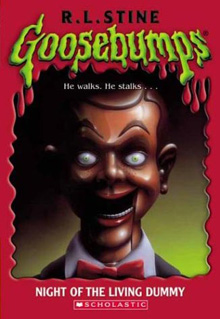 I recently encountered a familiar phenomenon. One of my undergrads approached me for advice concerning her younger sister, a “poor reader.” I later got a chance to talk to the 9-year-old, who described herself as “a poor reader,” saying she sometimes gets so bored that she falls asleep. But when I asked if she fell asleep reading Goosebumps books (which she’d mentioned as favorites), she exclaimed, “Oh no! Because it’s exciting... you don’t know what’s going to happen!” It also came out that she’s in her school choir, prefers jazz to classical music, loves to write (especially when she can choose the topic) and wants to be—I’m not kidding—a gynecologist.
I recently encountered a familiar phenomenon. One of my undergrads approached me for advice concerning her younger sister, a “poor reader.” I later got a chance to talk to the 9-year-old, who described herself as “a poor reader,” saying she sometimes gets so bored that she falls asleep. But when I asked if she fell asleep reading Goosebumps books (which she’d mentioned as favorites), she exclaimed, “Oh no! Because it’s exciting... you don’t know what’s going to happen!” It also came out that she’s in her school choir, prefers jazz to classical music, loves to write (especially when she can choose the topic) and wants to be—I’m not kidding—a gynecologist.
Of course it's possible that she has some reading issues. But it's clear that she's more than intelligent enough to be a good reader. A big part of the problem, it seems to me, is not the reader but what she’s reading.
Now consider the same phenomenon from a different angle. I once asked a conference audience—teachers, reading specialists, and others professionally involved in literacy—to be pretend-editors. I then described an “imaginary” manuscript, asking if they thought it suitable for 9- and 10-year-olds.
First I listed some vocabulary items from the text: pliable, transfixed, luminous, gibbering, travesty, pompous. Next, some phrases: “seized up,” “rue the day,” “a bemused expression.” Finally, some major themes and plot elements: “good” people often live in denial of political and military evil; intense and bitter bigotry that inspires physical violence; underlings in devotion to an evil leader, who controls them through terror and competitiveness.
When I then asked if they thought the story appropriate for the age-range, not a single attendee said yes: The vocabulary was too difficult, the concepts too complex—the book was sure to bore children.
A gasp arose when I revealed the manuscript was Harry Potter. These experienced professionals had rejected a series which we know many 9- and 10-year-olds are reading and understanding, enough to finish and rave about.
These examples reveal something of profound importance, I think, about literacy development. If children are sometimes mislabeled, or mislabel themselves, as “poor readers”—and if books as “difficult” as the Harry Potter series can enchant an entire generation—I have to ask if we're underestimating young readers. In any case, investigating the issue will illuminate some of the dynamics and complexities involved.
Consider some starting principles. I’m focusing on the nature of text, but there are of course other factors involved. Illustrations can play a huge role and topic can be profoundly motivating (consider The Babysitters Club series). Even marketing can make a significant difference. And children sometimes like books simply because their peers like them. But the nature of the text is, I think, the most basic aspect of any book’s ultimate success, or should be.
And of course I believe in certain natural developmental limits in young readers. Anyone who actually works with kids runs up against such limits all the time. My brilliant, literature-saturated 13-year-old reminded me of this recently, with her response to Jack London’s “To Build a Fire”: “The man sucked—the dog rocked!” Developmentalism, however, is sometimes seen as a lock-step process, but it's not! In The Pleasures of Children’s Literature, Perry Nodelman and Mavis Reimer point out that “…[f]aith in the Piagetian view of children…has diminished,” then quote psychologist William Kessen as saying “…we are in a post-Piagetian world.”
Even more important is to keep in mind that, ultimately, the reader-text connection is and should be mysterious. There’s a lot experts can say about this connection—but they can’t say it all. As Oscar Wilde put it, “Art is the most intense mode of individualism the world has ever known” and this reality automatically makes the relationship between book and reader something unique and unpredictable. I can't help but come to a fairly simple conclusion: When it comes to writing for children, don’t be afraid of complexity. There's more within their reach than we sometimes think.
There's also currently a shift in the field of reading toward the importance of “dispositions,” recognition that motivation and related factors play a central role. “Dispositions” are why “poor readers” of upper high-school age manage to perform well on their driver’s-license tests—why many “weak” students can memorize stanza after stanza of rap, or make up and recite their own—and why the eighth-grader my wife once knew, who read at a second-grade level, nevertheless thrived on the complex texts of audiophile magazines. Motivation, to put it succinctly, generally trumps readability. This doesn’t mean readability doesn’t matter—only that we’ve tended to overvalue it.
“Readability is not a formula,” says research in Reading to Learn in the Content Areas. “It is an exploration of what characteristics within the reader and within the text will create a successful marriage… Professional judgment is essential in determining readability; no score or formula can do more than help teachers understand the problems that may arise with reading materials.”
The main way to stop underestimating young readers, I think, is to believe they’re capable of surprising us. This will lead to more openness in our choices of appropriate texts—even to a somewhat “experimental” attitude, which by its very nature will be truly child-centered. And of course the pay-off is enormous. Children who are engaged in challenging and interesting texts become both more proficient as readers and more habituated to reading itself.
The essential point is while complexity shouldn’t be the make-or-break factor, there's another textual characteristic we can call primary. Any number of things can make a text motivating. But the king of them all is Story—the greatest ferry I know with which to cross the “zone of proximal development.” In any given narrative text, it seems to me, “readability” will work only in relationship to the power of Story or lack thereof.
“Acting,” Sir Ralph Richardson once said, “is merely the ability to keep a large group of people from coughing.” This ability is at the heart of the mysterious power of Story. In order to motivate our students more fully, we need to use Story as often and as effectively as possible.
“Thought flows in terms of stories—stories about events, stories about people, and stories about intentions and achievements,” said Frank Smith, a well-known reading researcher. “The best teachers are the best storytellers. We learn in the form of stories.”
So I propose Story as the true king of that unruly and magical country in which a child meets a text. For the best teaching is, as Yeats said, “not the filling of a pail, but the lighting of a fire.”
And I end with a Jewish proverb, a simple but profound bit of advice on how humans can best engage written language.
“Words should be weighed, not counted.”
 Tim J. Myers has more than 32 years' experience as a classroom and university teacher in English and education, was a university teacher educator for 20 years, and is now full-time in English at Santa Clara University. He is also a writer, songwriter, and storyteller with 15 published children’s books which have earned recognition from the New York Times, NPR, and Smithsonian. Find out more information at his website or on Facebook.
Tim J. Myers has more than 32 years' experience as a classroom and university teacher in English and education, was a university teacher educator for 20 years, and is now full-time in English at Santa Clara University. He is also a writer, songwriter, and storyteller with 15 published children’s books which have earned recognition from the New York Times, NPR, and Smithsonian. Find out more information at his website or on Facebook.